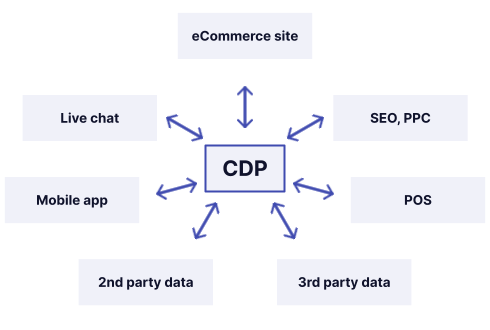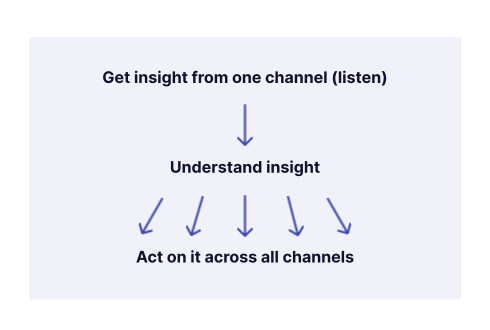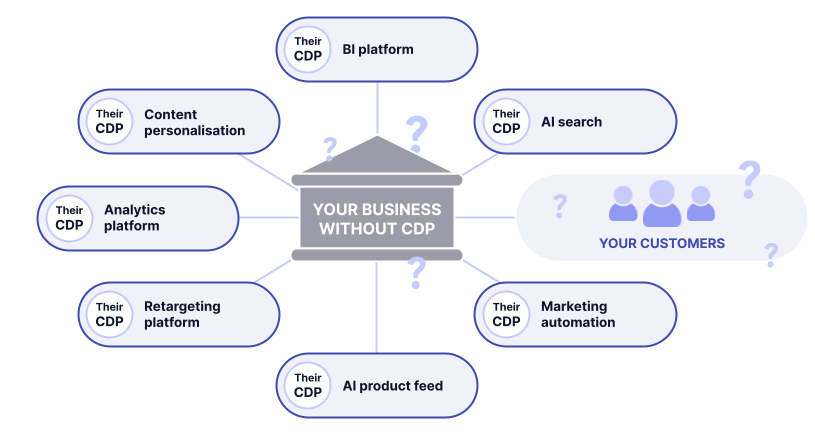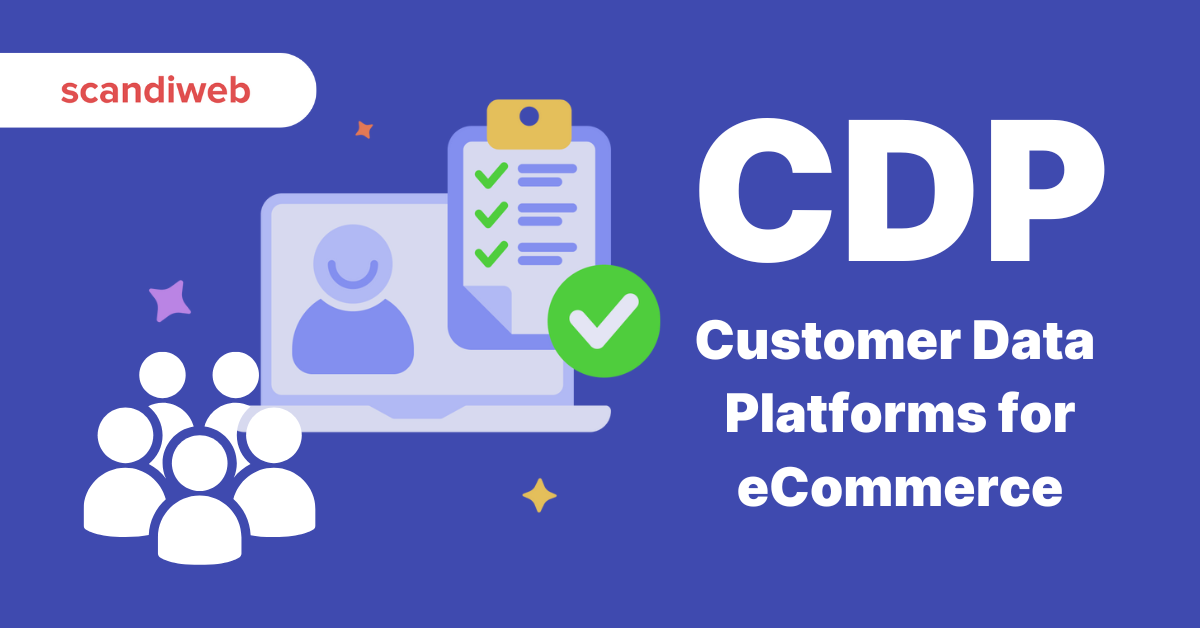Among popular eCommerce terms like PIM, PWA, CXM, and alike, customer data platform (CDP) gets very low exposure, adoption, and hype. Yet, this application targets the most crucial part of your business—your customers.
What is CDP?
A customer data platform—CDP—is a collection of software that creates a persistent, unified customer database accessible to other systems. Data is pulled from multiple sources, cleaned, and combined to create a single customer profile. This structured data is then made available to other marketing systems.
That’s the official definition. But let us tell you the story of Alice—here’s how CDP converts an anonymous visitor from a Google search into a user persona making purchases with a lifetime value of $20K.
Let’s break it down.
customer
At the heart of every CDP is the customer. A CDP creates a single, unified profile for each customer, aggregating information from every interaction they’ve had with your brand, including website visits, purchase history, social media interactions, and even in-store behaviors. If you understand customers at this granular level, you can tailor your marketing strategies to their preferences.
data
Data is the lifeblood of a CDP. It consists of information from websites, mobile apps, CRM systems, offline channels, and other sources, combined into one cohesive system. A CDP cleanses, organizes, and deduplicates this data to ensure accuracy and reliability. With a comprehensive data pool, you can uncover valuable insights, create targeted campaigns, and optimize customer journeys.
platform
The platform in a CDP stores and activates customer data. It integrates seamlessly with marketing, sales, and customer service tools. Platform examples include Salesforce Data Cloud, Segment, Insider, Adobe Experience Platform, and Bloomreach, each with automation capabilities that allow you to engage customers with personalized messages, offers, and experiences at just the right moments.
So, why is CDP not popular despite being the system to put customers at the center of your business? Its value lies outside of the platform itself. It comes from connections to other systems and the ability to receive, transform, store, and make customer behavior data available to other systems. Also, quality CDP implementation is more challenging and requires availability, alignment, and collaboration between people from different areas.
What makes a good CDP
The three pillars of an efficient CDP and its engine are the fundaments of great UX—listen, understand, and act, ensuring a 24/7 infinite loop of these actions.
- Listen—enrich a customer profile by collecting information on what the customer is doing across your channels (CDP sources): newsletter marketing platforms, display networks, eCommerce sites, blogs, search engines, in-store purchases, etc.
Ensure that your digital channels have data layers to collect information about your customer behavior and send it to CDP. For example, a data layer of an eCommerce platform would ingest the data about categories and products a user has browsed and items ordered.
- Understand—customer segmentation, segment-specific campaigns, and personalization scenarios. Once each customer has its story written in CDP, we can profile them and group customers (or not yet customers) into segments. We craft highly engaging, personalized offers and content for each segment and their combination, e.g., schedule a relevant newsletter or follow-up campaign.
- Act—integrations into eCommerce platform, display channels, retargeting platform, and email marketing. Such offers and content are packaged into campaigns across activation channels and displayed to these particular people who belong to a specific segment. CDP propagates its new knowledge about the customer across all destinations the customer connects to, be it blog, eCommerce, PPC, app, or other.


Ideally, you can listen to an interaction from one channel, understand it, and act better across all channels. The more you listen and understand a customer, the better you act, suggesting more relevant content and offers.
What happens if a business doesn’t have its CDP?
The harsh truth is—a business without CDP lets others store their customers’ behavioral data.

Your customer data is scattered across multiple 3rd parties. There is no end-to-end customer profile view, as each 3rd party and you own just a piece of total customer behavior, intentions, and transactional data. In turn, your customer experience suffers, and you spend too much on user acquisition because of a lack of understanding of the customer persona to target.
Features and benefits of a good CDP
CDP core features
Data layers and API connectors
CDPs feature data layers (sources) and API connectors (sources, destinations) that facilitate the tracking and recording customer interactions across various digital touchpoints—eCommerce platform, blog, mobile app, and email marketing campaigns. These connectors enable the CDP to gather data about what a customer has viewed or clicked on, collecting events, transactions, and redirects from all touchpoints to give a comprehensive view of customer behavior.
Activation channels (destinations)
Activation channels in a CDP focus on leveraging the collected customer data to deliver personalized experiences and communications—personalization API for instant delivery of relevant content. It enables the scheduling of segment or interest-based email campaigns and integration with retargeting and PPC platforms to enhance customer engagement and conversion through targeted and timely interactions.
Customer profile model
This is a flexible and extendable data model to support static data (such as demographic information), behavioral data (like browsing history or product preferences), and transactional data (purchase history), allowing businesses to create a dynamic and comprehensive profile for each customer, which can be continuously updated and enriched over time.
Segment engine
This enables businesses to create and manage various customer segments—manual segments based on specific criteria, calculated segments generated through rule-based algorithms, and campaign tagging based on customer segments, facilitating targeted marketing efforts.
CDP benefits
Unified customer data
One of the primary benefits of a CDP is its ability to centralize customer data from multiple sources into a consistent and unified view of each customer. It breaks down silos that traditionally exist in customer data, ensuring consistency and comprehensiveness in how customer information is handled and analyzed.
Personalization
CDPs help businesses to deliver real-time personalized experiences at scale. Merchants can tailor marketing campaigns, product recommendations, customer service, and more—you name it!—to suit individual customer profiles.
Improved decision making
CDPs significantly enhance decision-making capabilities by organizing and centralizing customer data. They often come with built-in dashboards or offer integration with business intelligence (BI) tools that can utilize CDP data.
Enhanced customer lifetime value and loyalty
CDPs significantly improve the return on advertising spend with more targeted and effective marketing strategies. This enhances customer lifetime value through better engagement strategies and personalized interactions. CDPs are also instrumental in creating and managing loyalty programs that resonate with your customers, fostering long-term relationships.
Compliance and data privacy
CDPs are crucial in managing customer data responsibly and ensuring compliance with data privacy regulations to build and maintain customer trust and business reputation.
Operational efficiencies
By automating various data management tasks, CDPs enhance operational efficiencies, saving time and resources. It’s particularly beneficial for eCommerce managers and marketers, as they can focus more on strategic tasks.
How CDP works in practice
Next, we have compiled real-life examples from CDP platforms managed for our existing clients.
- Store clerks and stylists receive comprehensive customer profile information before scheduled appointments, including calculated metrics and product preferences. These profiles contain the first and last transaction dates, lifetime revenue, last web visit date, last product purchased, and other details. Store clerks and stylists can tailor their assistance to each customer’s unique history and preferences, making it a highly personalized in-store experience.
- Using billing and shipping address information, a customer segment is created based on those within a 50km radius of a specific physical store. This segment is then targeted with email, SMS, or phone call campaigns to invite them to special events happening at the store, ensuring a higher likelihood of attendance and engagement and fostering a stronger connection with the local customer base.
- Automatically building and sending customer segments to advertising platforms, like Meta Ads and Google Ads, based on spending habits and activities. Customers are split into tiers by revenue in the last 12 months as well as nonbuyers, off-price customers typically seeking value deals, and full-price customers suitable for marketing messages about new collections and products.
- Collecting customer data from online stores when customers purchase a product that requires an app for usage. Once the product is in use, the company can gather data on how it is used through the app and analyze it to identify opportunities for upselling products.
- Targeted customer segments drive performance marketing ROI by more efficiently allocating marketing budgets toward a user and customer base already familiar with the brand. With annual costs of around $160k (excluding VAT), our client achieves a calculated ROI of 261% within one year and 501% over three years, purely from performance marketing.
Integrating a CDP into your business strategy can be a game-changer in how you understand and interact with your customers. The insights and functionalities offered by a CDP can empower your business to make informed decisions, build stronger customer relationships, and ultimately drive growth and success.
Ready to transform your digital strategy? Let’s place your customers in the very center! Contact us to learn more about CDP solutions and how they can benefit your business.


Share on: